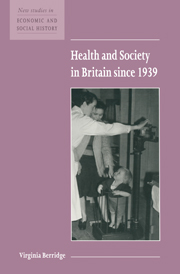Book contents
- Frontmatter
- Contents
- Acknowledgements
- List of abbreviations
- 1 Introduction: historiographical contexts. Writing about the war and post-war period
- 2 Health and the Second World War
- 3 Health policy, health and society, 1948–1974
- 4 Health policy, health and society, 1974–1990s
- 5 Conclusion
- Tables
- References
- Index
- New Studies in Economic and Social History
2 - Health and the Second World War
Published online by Cambridge University Press: 09 January 2010
- Frontmatter
- Contents
- Acknowledgements
- List of abbreviations
- 1 Introduction: historiographical contexts. Writing about the war and post-war period
- 2 Health and the Second World War
- 3 Health policy, health and society, 1948–1974
- 4 Health policy, health and society, 1974–1990s
- 5 Conclusion
- Tables
- References
- Index
- New Studies in Economic and Social History
Summary
Before looking at how these fundamental changes affected the post-war period, we first need to examine how health services – and also the health experience of the population – were affected by the Second World War. By the outbreak of war in 1939, there was no lack of knowledge of the chaotic and uncoordinated nature of health services in terms of distribution, access, financing and much else (Cherry, 1996). The patchwork of services included voluntary hospitals on the point of bankruptcy, insurance coverage which largely excluded dependants, and low morale among both GPs and consultants, together with the local authority-based public health service, which had taken on some Poor Law medical functions in the 1930s. In 1937, a Political and Economic Planning (PEP) report on The British Health Services underlined how ‘a bewildering variety of agencies, official and unofficial, have been created during the past two or three generations to work for health mainly by attacking specific diseases and disabilities as they occur’ (quoted in Pater, 1981 p. 19). Disease-specific services were extended when the 1939 Cancer Act laid the foundations for diagnosis organised by local authorities with coordination at regional level (there were already public TB and VD services). This emphasis on regional organisation foreshadowed the later NHS. The existing pattern of private and voluntary services, of public and local authority provision, could not effectively satisfy the need for health care, even if, as recent research has shown, the pre-war service was more responsive than once thought (Powell, 1997).
- Type
- Chapter
- Information
- Health and Society in Britain since 1939 , pp. 10 - 22Publisher: Cambridge University PressPrint publication year: 1999



